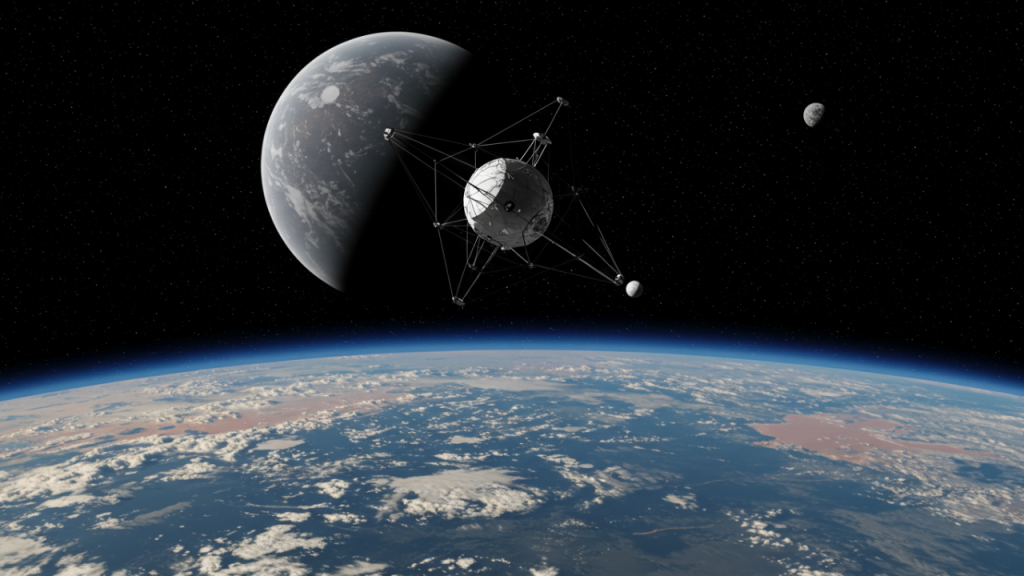NASA scientists study things on Earth and in space. They also make and send spacecraft to explore planets and even farther away.
IMAP will use 10 instruments to map and learn more about the heliosphere, the huge bubble around our solar system that protects us from radiation from interstellar space.
Interstellar Mapping and Acceleration Probe (IMAP)
IMAP is a spacecraft that will chart the vast space around the Sun called the heliosphere. It will investigate two important overarching themes in heliophysics—how the Sun energizes charged particles and how the solar wind interacts with its boundary with interstellar space. The mission uses ten scientific instruments to map what’s roiling in space, from the Sun to the outer edges of the heliosphere.
When the spacecraft is in its orbit around Earth at the first Earth-Sun Lagrange point, it will also provide real-time observations of solar storms that can flood near-Earth’s space environment with dangerous particles and radiation that could harm voyaging astronauts and satellites, as well as disrupt global communications and power grids on Earth.
The SpaceX Falcon 9 rocket is scheduled to launch IMAP, Carruthers Geocorona Observatory (CGO) and National Oceanic and Atmospheric Administration’s (NOAA) Space Weather Follow On-Lagrange 1 (SWFO-L1) as rideshares this morning at 7:30 a.m. EDT from NASA’s Kennedy Space Center Launch Complex 39A in Florida. NASA’s live launch coverage begins at 6:40 a.m. EDT on NASA+, on Amazon Prime and on the agency’s YouTube channel. Spanish language launch coverage is available on NASA’s Spanish-language YouTube channel.
After launch, IMAP will separate from the CGO and SWFO-L1 satellites about 84 minutes after liftoff and enter its own solar transfer orbit to the Sun-Earth L1 point. Once it arrives there, the mission will begin to measure how fast the solar wind is flowing and how fast particles are accelerated. It will also study the structure of the Sun’s magnetic bubble, called the heliosphere, and track the movement of the boundaries between the heliosphere and interstellar space.
In order to identify the origin of the solar winds, IMAP will use a new instrument called GLOWS. This instrument detects the Lyman-a photons emitted by hot plasma, which have a characteristic shape that can be traced back to their sources. Using a baffle to limit the field of view, the instrument can focus on specific locations of the heliosphere, and then a spectral filter identifies only the Lyman-a wavelengths that reach the detector. The photons are then counted, and this data will be used to build a three-dimensional map of the structure of the solar wind.
The other eight IMAP instruments are designed to measure a wide range of other particles and phenomena. IMAP-Lo, IMAP-Hi and IMAP-Ultra detect ions in the solar wind; IMAP-EXP, SWE and CoDICE are charged particle detectors; and IDEX and MAG measure dust. Together, IMAP’s ten instruments will simultaneously dissect particle injection and acceleration processes in the inner heliosphere and remotely probe the outer heliosphere for their response. IMAP is a part of NASA’s Heliophysics System Observatory Program, managed by Goddard’s Heliophysics Science Division. Other STP missions include the Solar Terrestrial Probes, Solar Dynamics Observatory and Chandra X-ray telescope.

Carruthers Geocorona Observatory
A SpaceX Falcon 9 rocket launched three space weather probes today from NASA’s Kennedy Space Center in Florida. The Carruthers Geocorona Observatory, the Interstellar Mapping and Acceleration Probe (IMAP), and the National Oceanic and Atmospheric Administration’s Space Weather Follow On-Lagrange 1 (SWFO-L1) will all work toward a common goal: understanding space weather and its effects on Earth.
Carruthers is a new spacecraft designed to observe Earth’s outermost atmosphere, known as the exosphere, which extends more than half of the way to the Moon. Specifically, it will track the faint glow of hydrogen atoms in the region, which is visible in ultraviolet light. This bright emission is the most important signal for revealing the shape and density of the region, and how it changes in response to solar wind and other space weather disturbances.
The mission will be positioned at the sun-Earth Lagrange point 1, an orbital spot that is gravitationally stable and relatively distant from both our planet and the Sun. From this vantage point, the spacecraft will have an uninterrupted view of the exosphere and its response to solar winds and other space weather events. It will use two ultraviolet imaging instruments to detect the brightness of hydrogen atoms, which are the most abundant particle in the exosphere. The other instrument, called the High Energy Ion Telescope (HIT), will measure ions in the exosphere.
In addition to tracking the exosphere, the Carruthers spacecraft will also study its interaction with the heliosphere, a vast magnetic bubble that protects our solar system from radiation emitted from interstellar space. The 10 science instruments on the IMAP mission will scan the heliosphere to understand how the solar wind and solar flares impact it. The instrumentation will include a magnetometer to measure the Sun’s magnetic field, an X-ray telescope to detect plasma particles and energetic ions, and a high-energy ion instrument to measure ions originating from solar wind and the heliosphere.
The SWFO-L1 craft will act as an early warning system, tracking coronal mass ejections (CMEs), which are solar storms that can disrupt satellites, power grids, aircraft, and even astronauts on the International Space Station. By tracking CMEs, the SWFO-L1 can tell officials when and where to expect a storm, and take measures to keep them safe. The spacecraft will also track solar wind, which is what makes it a great tool for forecasting space weather.
Space Weather Follow On-Lagrange 1 (SWFO-L1)
A trio of Sun-studying spacecraft is ready to blast off from NASA’s Kennedy Space Center on Wednesday. A Falcon 9 rocket will lift off at 7:30 a.m. EDT (1130 GMT) with the agency’s Interstellar Mapping and Acceleration Probe (IMAP), the National Oceanic and Atmospheric Administration’s Carruthers Geocorona Observatory, and NOAA’s Space Weather Follow On-Lagrange 1 (SWFO-L1) mission riding in a rideshare arrangement.
Once in orbit, the SWFO-L1 satellite will track solar wind disturbances and coronal mass ejections before they reach Earth. It will then send those data to NOAA’s Space Weather Prediction Center in Boulder, Colorado, allowing for faster forecasts and watches. This information will help protect power grids, satellite systems, planes in the air and astronauts at the International Space Station.
The mission will use a suite of sensors to make in-situ measurements of the thermal plasma of the solar wind and its magnetic field. It will also detect solar flares and Coronal Mass Ejections, which are giant eruptions of solar material that can damage satellites, interfere with power transmission and disrupt telecommunications. The SWFO-L1 instrument, called the Magnetometer (MAG), will record variations in the interplanetary magnetic field that could be caused by shocks from coronal mass ejections or corotating interaction regions.
Ball Aerospace won a contract in 2020 to build, integrate and operate the SWFO-L1 spacecraft. The company will design, analyze, fabricate and test the magnetometer instrument that will measure vector interplanetary magnetic fields. It will also supply and maintain the instrument Ground Support Equipment. Ball will support the mission’s launch and on-orbit check-out, as well as provide engineering and mission operations support until NOAA takes over at the end of the mission.
NOAA will consider alternatives for maintaining a capability to monitor space weather in orbit once SWFO-L1’s five-year mission ends, an agency official said Jan. 24 during a virtual meeting of the American Meteorological Society. The agency will consider a range of options for the next satellite to have an Earth-Sun L-1 type orbit, Elsayed Talaat, Projects, Planning and Analysis director in NOAA’s National Environmental Satellite Data and Information Service, told the meeting.
In other space technology news, L3Harris was awarded a contract in 2021 to develop and deploy and for up to two years of operations support a command and control system for NOAA’s GOES-R Series geostationary satellites. Specifically, the company will add the capability to its scalable GOES-R Core Ground System, which will be used to support the launch of the SWFO-L1 observatory. This observatory will keep an eye on the Sun from a spot about a million miles away, detecting solar winds and CMEs before they can impact the power grid, planes in the sky or satellites that transmit critical data to Earth. The resulting real-time forecasts, watches and warnings will improve the nation’s ability to protect critical elements vital to our economy and security, including telecommunication and navigation satellites and the power grid.



